| Listing 1 - 10 of 12 | << page >> |
Sort by
|
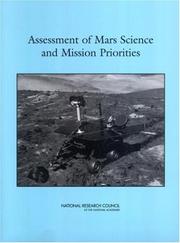
ISBN: 0309089174 9786610179800 1280179805 0309508339 9780309508339 9781280179808 6610179808 9780309089173 0309167930 Year: 2003 Publisher: Washington, D.C. : National Academies Press,
Abstract | Keywords | Export | Availability | Bookmark
 Loading...
Loading...Choose an application
- Reference Manager
- EndNote
- RefWorks (Direct export to RefWorks)
Electronic books. -- local. --- Mars (Planet) -- Exploration -- Government policy -- United States. --- Mars (Planet) -- Exploration. --- Astronomy & Astrophysics --- Physical Sciences & Mathematics --- Astrophysics --- Mars (Planet) --- Exploration. --- Exploration --- Government policy --- Red Planet
Book
ISSN: 03796566 ISBN: 9789292219758 9292219758 Year: 2009 Volume: 1291 Publisher: Noordwijk ESA
Abstract | Keywords | Export | Availability | Bookmark
 Loading...
Loading...Choose an application
- Reference Manager
- EndNote
- RefWorks (Direct export to RefWorks)
Space flight to Mars --- Mars (Planet) --- Exploration --- 523.43 --- Mars --- 523.43 Mars --- Interplanetary voyages --- Mars (Planet) - Exploration
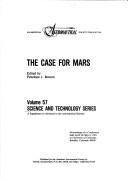
ISSN: 02784017 ISBN: 0877031975 0877031983 9780877031970 9780877031987 Year: 1984 Volume: 57 Publisher: San Diego American Astronautical Society
Abstract | Keywords | Export | Availability | Bookmark
 Loading...
Loading...Choose an application
- Reference Manager
- EndNote
- RefWorks (Direct export to RefWorks)
Space flight to Mars --- Congresses --- Mars (Planet) --- Exploration --- Space flight to Mars - Congresses --- Mars (Planet) - Exploration - Congresses
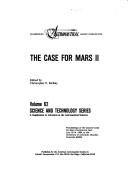
ISSN: 02784017 ISBN: 0877032203 087703219X 9780877032199 9780877032205 Year: 1985 Volume: 62 Publisher: San Diego American Astronautical Society
Abstract | Keywords | Export | Availability | Bookmark
 Loading...
Loading...Choose an application
- Reference Manager
- EndNote
- RefWorks (Direct export to RefWorks)
Space flight to Mars --- Congresses --- Mars (Planet) --- Exploration --- Space flight to Mars - Congresses --- Mars (Planet) - Exploration - Congresses

ISBN: 0852740263 Year: 1989 Publisher: Bristol Hilger
Abstract | Keywords | Export | Availability | Bookmark
 Loading...
Loading...Choose an application
- Reference Manager
- EndNote
- RefWorks (Direct export to RefWorks)
Mars (Planet) --- Exploration --- Mars (Planet) - Exploration. --- Astronautics in astronomy. --- Astronautics in astronomy --- 523.43 --- Astronomy --- Space astronomy --- 523.43 Mars --- Mars --- Exploration.
Book
ISBN: 9783319124483 3319124471 9783319124476 331912448X Year: 2015 Publisher: Cham : Springer International Publishing : Imprint: Springer,
Abstract | Keywords | Export | Availability | Bookmark
 Loading...
Loading...Choose an application
- Reference Manager
- EndNote
- RefWorks (Direct export to RefWorks)
With current technology, a voyage to Mars and back will take three years. That’s a lot of time for things to go wrong. But sooner or later a commercial enterprise will commit itself to sending humans to Mars. How will the astronauts survive? Some things to consider are: ith current technology, a voyage to Mars and back will take three years. That’s a lot of time for things to go wrong. But sooner or later a commercial enterprise will commit itself to sending humans to Mars. How will the astronauts survive? Some things to consider are: • Who decides what medical resources are used for whom? Who decides what medical resources are used for whom? • What is the relative weight of mission success and the health of the crew? What is the relative weight of mission success and the health of the crew? • Do we allow crewmembers to sacrifi ce their lives for the good of the mission? Do we allow crewmembers to sacrifi ce their lives for the good of the mission? • And what if a crewmember does perish? Do we store the body for return to Earth or give the member a burial in space? Questions like these, and hundreds of others, have been explored by science fi ction, but scant attention has been paid by those designing missions. Fortunately, the experience gained in polar exploration more than 100 years ago provides crews and mission planners with a framework to deal with contingencies and it is this that forms the core of this book. Why the parallels between polar and space exploration? Because polar exploration offers a better analogy for a Mars mission today than those invoked by the space community. Although astronauts are routinely compared to Lewis and Clark, Mars-bound astronauts will be closer in their roles to polar explorers. And, as much as space has been described as a New Frontier, Mars bears greater similarity to the polar regions, which is why so much can be learned from those who ventured there. And what if a crewmember does perish? Do we store the body forreturn to Earth or give the member a burial in space? Questions like these, and hundreds of others, have been explored by science fi ction, but scant attention has been paid by those designing missions. Fortunately, the experience gained in polar exploration more than 100 years ago provides crews and mission planners with a framework to deal with contingencies and it is this that forms the core of this book. Why the parallels between polar and space exploration? Because polar exploration offers a better analogy for a Mars mission today than those invoked by the space community. Although astronauts are routinely compared to Lewis and Clark, Mars-bound astronauts will be closer in their roles to polar explorers. And, as much as space has been described as a New Frontier, Mars bears greater similarity to the polar regions, which is why so much can be learned from those who ventured there.
Engineering. --- Aerospace Technology and Astronautics. --- Popular Science in Astronomy. --- Planetology. --- Astronomy. --- Astronautics. --- Ingénierie --- Planétologie --- Astronomie --- Astronautique --- Manned space flight. --- Mars (Planet) -- Exploration. --- Polar regions -- Discovery and exploration. --- Mechanical Engineering --- Engineering & Applied Sciences --- Aeronautics Engineering & Astronautics --- Mars (Planet) --- Polar regions --- Exploration. --- Discovery and exploration. --- Aerospace engineering. --- Space flight --- Astronauts --- Planetary sciences --- Planetology --- Space sciences --- Aeronautics --- Astrodynamics --- Space vehicles --- Aeronautical engineering --- Astronautics --- Engineering
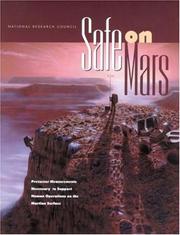
ISBN: 0309084261 9786610183784 1280183780 0309502004 9780309502009 030908654X 9780309086547 9780309084260 0305084261 0309169593 Year: 2002 Publisher: Washington, D.C. : National Academy Press,
Abstract | Keywords | Export | Availability | Bookmark
 Loading...
Loading...Choose an application
- Reference Manager
- EndNote
- RefWorks (Direct export to RefWorks)
Electronic books. -- local. --- Mars (Planet) -- Equipment and supplies. --- Mars (Planet) -- Exploration. --- Mars surface samples -- Contamination. --- Mars surface samples. --- Planetary quarantine. --- Mars surface samples --- Planetary quarantine --- Astrophysics --- Astronomy & Astrophysics --- Physical Sciences & Mathematics --- Contamination --- Contamination. --- Mars (Planet) --- Exploration. --- Equipment and supplies. --- Mars samples --- Red Planet --- Quarantine --- Space biology --- Space vehicles --- World health --- Sterilization
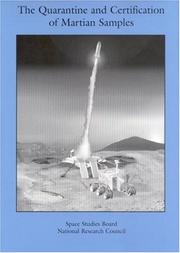
ISBN: 0309075718 9780309511518 0309511518 9780309511513 9780309075718 0305075718 0309170753 Year: 2002 Publisher: Washington, D.C. National Academy Press
Abstract | Keywords | Export | Availability | Bookmark
 Loading...
Loading...Choose an application
- Reference Manager
- EndNote
- RefWorks (Direct export to RefWorks)
Mars (Planet) -- Exploration -- Equipment and supplies. --- Mars surface samples -- Contamination. --- Mars surface samples. --- Planetary quarantine. --- Space vehicles -- Contamination. --- Mars surface samples --- Planetary quarantine --- Space vehicles --- Astrophysics --- Astronomy & Astrophysics --- Physical Sciences & Mathematics --- Contamination --- Contamination. --- Mars (Planet) --- Exploration --- Equipment and supplies. --- Mars samples --- Equipment --- Contamination (Technology) --- Quarantine --- Space biology --- World health --- Sterilization
Book
ISSN: 03796566 ISBN: 9290923938 9789290923930 Year: 2007 Volume: 1299 Publisher: Noordwijk ESA communications
Abstract | Keywords | Export | Availability | Bookmark
 Loading...
Loading...Choose an application
- Reference Manager
- EndNote
- RefWorks (Direct export to RefWorks)
Life on other planets --- Mars (Planet) --- Exploration --- Atmosphere --- Surface --- Water --- 573.5 --- 574.23 --- Problem of the origin of life. Life on other planets. Exobiology --- Extremal conditions. The limits of tolerance --- 574.23 Extremal conditions. The limits of tolerance --- 573.5 Problem of the origin of life. Life on other planets. Exobiology --- Extraterrestrial life --- Planets --- Fermi's paradox --- Atmosphere. --- Exploration. --- Surface. --- Water. --- Mars (Planet) - Exploration --- Mars (Planet) - Atmosphere --- Mars (Planet) - Surface --- Mars (Planet) - Water

ISBN: 9780387683676 0387402128 9780387402123 9786612823978 0387683674 1282823973 Year: 2007 Publisher: New York : Copernicus Books in association with Praxis Pub.,
Abstract | Keywords | Export | Availability | Bookmark
 Loading...
Loading...Choose an application
- Reference Manager
- EndNote
- RefWorks (Direct export to RefWorks)
Peter Bond provides an overview of key, unmanned missions, chapter by chapter, to planets in the twentieth century. He tells the story of the mission planners and engineers who, working mostly in the background, made these unprecedented achievements in scientific exploration possible. Bond’s perspective provides a much-needed overview, but it also details the very human feelings that animated the intense rivalries between the Soviet Union and the United States, and most recently the difficulties that arose in collaborations between NASA and ESA on the Rosetta and Halley's Comet missions.
Physics. --- Astronomy, Astrophysics and Cosmology. --- Popular Science in Astronomy. --- Aerospace Technology and Astronautics. --- Science, general. --- Science (General). --- Astronomy. --- Astronautics. --- Physique --- Astronomie --- Astronautique --- Asteroids. --- Comets. --- Jupiter (Planet) -- Exploration. --- Mars (Planet) -- Exploration. --- Mercury (Planet) -- Exploration. --- Moon -- Exploration. --- Neptune (Planet) -- Exploration. --- Outer space -- Exploration. --- Planets -- Exploration. --- Pluto (Dwarf planet) -- Exploration. --- Saturn (Planet) -- Exploration. --- Uranus (Planet) -- Exploration. --- Venus (Planet) -- Exploration. --- Planets --- Astrophysics --- Astronomy - General --- Astronomy & Astrophysics --- Physical Sciences & Mathematics --- Exploration --- Planets. --- Exploration. --- Outer space --- Solar system --- Science. --- Astrophysics. --- Cosmology. --- Aerospace engineering. --- Science, Humanities and Social Sciences, multidisciplinary. --- Space sciences --- Aeronautics --- Astrodynamics --- Space flight --- Space vehicles --- Aeronautical engineering --- Astronautics --- Engineering --- Astronomical physics --- Astronomy --- Cosmic physics --- Physics
| Listing 1 - 10 of 12 | << page >> |
Sort by
|

 Search
Search Feedback
Feedback About UniCat
About UniCat  Help
Help News
News